Andy, can you point me to the thread with the schematic that I can use as a starting point for the dht?
Great. If what goes into this tube stage is different than what comes out, that can be measured and quantified using less poetic terms that might be useful to others trying to understand what is really going on. "more transparent" could mean anything. Changes that apply only to acoustic instruments seems like a fantasy to me. Certainly less noise, less distortion, a gain enhancement of some range of frequencies could be the cause. As you only get more noise and more distortion by adding a tube stage where there was only wire before, it's not going to be that. So we're probably talking about more distortion or some frequency response change.Personally I would always prefer a DHT over an indirectly heated tube. When you talk of "tube sound" it's not the "warm" kind of sound you may be imagining, but instead a more transparent sound with more subtle tone to acoustic instruments. Addictive once you start using DHTs.
Imagination is a wondrous talent. A double blind test with several participants seperated from easch other reveals quite a bit.
What kind of distortion do we like best? Is the decision based on the phase of the Moon? 😀
What kind of distortion do we like best? Is the decision based on the phase of the Moon? 😀
In your dreams. You want to "measure" why DHTs sound different? Many others have tried so add your name to the list. Do you actually have ANY experience of building with DHT small tubes? I've been doing it for 12 years and with a large number of different DHT tubes, e.g. 10Y, 4P1L, 2P29L, 01A, 112A, 26, 46, 47, 71A, 30, 31 etc etc. This is a subject I know very well. What are your own direct experiences of DHT builds?Great. If what goes into this tube stage is different than what comes out, that can be measured and quantified using less poetic terms that might be useful to others trying to understand what is really going on.
https://www.diyaudio.com/community/threads/4p1l-dht-line-stage.190857/page-93#post-7233397Andy, can you point me to the thread with the schematic that I can use as a starting point for the dht?
Here's a typical schematic. Look closely at it - it's in what's known as "filament bias". The filament supply goes through the cathode resistor, which is why it's small. You will need a pair of economically priced V9 filament regs from Rod Coleman at Lyrima. He will supply all the build details you need and answer any questions including heatsinks. The filament supply is separate for each valve, so 2 supplies needed which are floating. You could use a 12+12V transformer at 25VA or 30VA for instance, then dropper resistors to get to 12V each valve. Many people have built this kind of line stage in filament bias, which has become the favoured method for DHTs because it has no cathode bypass cap. Output impedance should be around 1.5K. 4P1Ls are cheap and available, mostly from ex-Soviet European countries.
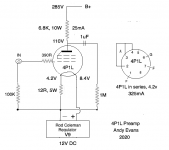
Last edited:
I think we have to lower the gain of the class d amplifier before adding a tube preamp .
I am still mulling over writing such a plugin based on transfer function emulation. Make your clean class-D amp sound like a tube amp distortion machine! Makes so much sense, right?
While I am at it, maybe I should create a plugin that adds random ticks and pops and some background vinyl noise. That seems to be all the rage these days, too.
While I am at it, maybe I should create a plugin that adds random ticks and pops and some background vinyl noise. That seems to be all the rage these days, too.
Last edited:
Andy,If you don't have a Class D amp ready then look at the Pass First Watt designs. The F4 is often used with a tube input. There are many other Pass designs in Class A. They run hot, but good amps and many have built them.
I do have the class D modules already. It's the Orchard Audio Starkrimson ultra. From your DHT adventures, which would be most suitable for "tube buffer" or just couple db of gain? Also, not too microphonic, and affordable? I read that the 4P1L is very microphonic, and have you found that to be true?
The 4P1L can be somewhat microphonic, but not "very microphonic". It needs a solid non-resonant enclosure. I used 4mm aluminium top plates. Others have used damping. It's something that can be controlled with the right kind of attention.
If it were me I would use a 6C4C in filament bias. That's a Russian 6B4G, a 6.3V version of a 2a3. Again, Rod Coleman V9 regs. This is a very good sounding valve made by Svetlana. It will sound better than a 4P1L but not by a huge amount. It requires an overkill construction with a large heatsink for the regs and the cathode resistors will get very hot and need to be mounted on top of the chassis. A 2a3 could be used with a cathode bypass cap, but if it were me I would use filament bias because it sounds cleaner. I attach a schematic, but this is a more advanced build. Worth it in my opinion. But the choice will be up to you. There are many simpler designs, like the 4P1L for one.
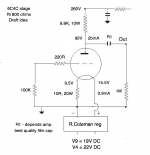
If it were me I would use a 6C4C in filament bias. That's a Russian 6B4G, a 6.3V version of a 2a3. Again, Rod Coleman V9 regs. This is a very good sounding valve made by Svetlana. It will sound better than a 4P1L but not by a huge amount. It requires an overkill construction with a large heatsink for the regs and the cathode resistors will get very hot and need to be mounted on top of the chassis. A 2a3 could be used with a cathode bypass cap, but if it were me I would use filament bias because it sounds cleaner. I attach a schematic, but this is a more advanced build. Worth it in my opinion. But the choice will be up to you. There are many simpler designs, like the 4P1L for one.

That's great you've been playing with valves for 12 years. Your apparent reluctance to measure and quantify and make records of the performance all these tube stages indicates it's a subject you have accumulated little objective knowledge of. Now typical 24 bit 96 ksps measurements are easy to make these days. With such a measurement resolution that greatly exceeds the hearing resolution of any human hearing the transfer function for a particular tube or amplifier stage can be measured, quantified and even simulated as many companies are doing with DAW plug ins. After all the digital music you are playing is just a sequence of measurements. Capturing the stream after it has gone through a tube stage is another set of measurements. The difference between them is due to the transfer function of the device which can be deduced by looking at the difference in detail. My interest is in high fidelity sound reproduction systems. I leave the addition of color and harmonics to the artists that create the content rather than adding distortion and frequency response alterations using low fidelity valve or other components with flowery descriptions that "can't be quantified" and are only appreciated by experts or priests in the audiophile sanctuaries.In your dreams. You want to "measure" why DHTs sound different? Many others have tried so add your name to the list. Do you actually have ANY experience of building with DHT small tubes? I've been doing it for 12 years and with a large number of different DHT tubes, e.g. 10Y, 4P1L, 2P29L, 01A, 112A, 26, 46, 47, 71A, 30, 31 etc etc. This is a subject I know very well. What are your own direct experiences of DHT builds?
Last edited:
Your mocking tone and deliberate belittling of valve technology and of myself - "playing with valves" means that you have absolutely no respect from me and never will have. While you were measuring sine waves and white noise I was getting my conservatoire degree in music, and then playing in symphony orchestras, theatres, recording studios and clubs in several different countries. I am extremely familiar with the tonality of acoustic instruments and reproducing them as faithfully as possible has always been my goal. Since I listen to music and not sine waves I have used whatever technology brings me closest to the sound of live music, and done this diligently and methodically over 12 years. Since I am also a psychologist I also know how to set up experiments and what can be expected from them.
Since your own experiments with audio have failed to show you what DHTs can bring to music in terms of tonality I can only assume that either you have much to learn or have cloth ears and music such as classical music and opera doesn't really matter much to you. As such you might just as well be an expert in hot air balloons, since whatever knowledge you have acquired appears to be irrelevant to the core of music reproduction which is the music itself.
Since your own experiments with audio have failed to show you what DHTs can bring to music in terms of tonality I can only assume that either you have much to learn or have cloth ears and music such as classical music and opera doesn't really matter much to you. As such you might just as well be an expert in hot air balloons, since whatever knowledge you have acquired appears to be irrelevant to the core of music reproduction which is the music itself.
The only device worth using to amplify a signal voltage is a triode IMHO. Perhaps a SIT but rare and costly - I don't use pentodes for the same reason as not using BJT - I want a voltage controlled resistance.
Never used a DHT and probably never will because the fimament/cathode is a pain in the butt compared to IHT like 6SN7 though.
The only reason I've never done "measurements" is I've been to lazy to set up REW... I figure if the scope shows a clean sinewave at 100V, at 5V it'll be just fine. Nobody seems to design a solid state stage with that much headroom even though I've done it with IXTP08N100D2 depletion MOSFETs...
EDIT: Here's what I came up with... gain is ~ 60 with R23, R28 = 0R. Gain is ~6 with R23, R28 = 2k7

Never used a DHT and probably never will because the fimament/cathode is a pain in the butt compared to IHT like 6SN7 though.
The only reason I've never done "measurements" is I've been to lazy to set up REW... I figure if the scope shows a clean sinewave at 100V, at 5V it'll be just fine. Nobody seems to design a solid state stage with that much headroom even though I've done it with IXTP08N100D2 depletion MOSFETs...
EDIT: Here's what I came up with... gain is ~ 60 with R23, R28 = 0R. Gain is ~6 with R23, R28 = 2k7
Last edited:
1) Playing with different circuits is great fun. Unless it follows a scientific method it is unlikely to accurately and efficiently accumulate knowledge. 2) Valves or FETS or BJTs, if designed to introduce a change in the sound, are doing that by creating distortion or frequency response changes. That's a very fundamental idea of system engineering. If it changes the sound, it isn't reducing the distortion and it doesn't have a flat frequency response. Not sure how you find that fundamental fact insulting to valve technology. If the stage changes the sound, that is the opposite of high fidelity. When I sit in a room with a cello playing a few feet away, it is absurd to think that adding a valve stage to that experience would bring me closer to the live experience. The recording engineering when mixing and mastering will introduce compression, distortion to elevate harmonics, reverb to simulate space, and equalization filtering to produce an artificially sweetened sound that wasn't in the performance. Hey, it's art designed to be entertaining. Nearly all the recordings you can buy and listen to have been through this process. Even recording made without equalization or compression with microphones directly feeding a digital recorder have distortion and frequency response signatures that are unique to that microphone and the position it is in relative to the source. By applying more distortion and equalization that is baked into the design of a preamp or amplifier, you are just doing more of the same in a way that you find pleasant. 3) If your argument leans on an "Appeal to Authority" that you feel you have gained through your training and experience rather than easily demonstrated factual information you might research logical fallacies and seek some guidance from fellow psychologists for why you are so easily disturbed when your statements are questioned. It's neat that you enjoy the color and distortion introduced by a tube stage. If it changes the sound, it's not high fidelity, ie input == output. Audiophiles are typically not interested in high fidelity. They love the art of beautiful heavy expensive equipment, the praise of reviewers, the shiny jewelry of precious metal fuses, cables and cones, and the poetry of undefined descriptive terms regarding the sound of their carefully curated mega buck systems. It's a fun hobby. Some times it intersects with high fidelity, but not as often as you might think. If you want to be close to live sound, get an invite to a well damped practice studio.Your mocking tone and deliberate belittling of valve technology and of myself - "playing with valves" means that you have absolutely no respect from me and never will have. While you were measuring sine waves and white noise I was getting my conservatoire degree in music, and then playing in symphony orchestras, theatres, recording studios and clubs in several different countries. I am extremely familiar with the tonality of acoustic instruments and reproducing them as faithfully as possible has always been my goal. Since I listen to music and not sine waves I have used whatever technology brings me closest to the sound of live music, and done this diligently and methodically over 12 years. Since I am also a psychologist I also know how to set up experiments and what can be expected from them.
Since your own experiments with audio have failed to show you what DHTs can bring to music in terms of tonality I can only assume that either you have much to learn or have cloth ears and music such as classical music and opera doesn't really matter much to you. As such you might just as well be an expert in hot air balloons, since whatever knowledge you have acquired appears to be irrelevant to the core of music reproduction which is the music itself.
Last edited:
Let me tell you a few educational things about music, what it means and how to record it.
I spent one very interesting evening in the Oslo studio of Jan Erik Kongshaug who was for many years one of the principal recording engineers for ECM records. Present were a few fellow musicians including Jon Christensen, the drummer on Keith Jarrett's ECM recordings. Jan Erik played back the master tape of one of the Keith Jarrett sessions he recorded and Jon asked him to play back just the drum tracks, which we listened to for a good while. What was immediately striking was how beautifully musical the drum kit sounded. Extended listening made it clear that the reason why wasn't anything particularly technical, though the studio was well equipped and had one of the nicest Steinways I've ever played. The reason why was simple. Jan Erik was a deeply musical person. He was himself a good guitarist and ..... the guy was simply very, very musical. He knew by ear exactly how to record a drum kit, which is why musicians loved using him in the studio.
In contrast I could tell you of train wreck recording sessions I've been on where the engineer thought he was smarter than the musicians who wrote, arranged and played the music because he "understood recording technology" and over-ruled their wishes for how they wanted the music to sound. Recording engineers like that don't get used twice by musicians.
If you have any further doubts about how overwhelmingly important tonality is to professional musicians take 17 minutes out of your life and listen to concert pianist Tiffany Poon describing how she spent a whole day in the Steinway showrooms in New York choosing a Type B Steinway grand for her personal use. The tiniest of nuances are so critical to professional musicians when it comes to the instruments they use - see how she tries one piano after another, saying "this is good for Chopin", "this would be good for a concerto with orchestra" and so on.
And then maybe - just maybe - you might start to have some faint understanding of why I have spent 12 years listening to a huge number of DHTs for the tiniest nuances of what sounds like real acoustic instruments. What makes a Steinway sound like a Steinway and not a Bosendorfer or a Bechstein grand (which incidentally I grew up on). Just as Tiffany spends a lifetime listening to the tonality of the instruments she plays. And the same for all other professional musicians who have the innate musicality to understand the tiniest nuances of the live acoustic instruments they live with and play together with.
I spent one very interesting evening in the Oslo studio of Jan Erik Kongshaug who was for many years one of the principal recording engineers for ECM records. Present were a few fellow musicians including Jon Christensen, the drummer on Keith Jarrett's ECM recordings. Jan Erik played back the master tape of one of the Keith Jarrett sessions he recorded and Jon asked him to play back just the drum tracks, which we listened to for a good while. What was immediately striking was how beautifully musical the drum kit sounded. Extended listening made it clear that the reason why wasn't anything particularly technical, though the studio was well equipped and had one of the nicest Steinways I've ever played. The reason why was simple. Jan Erik was a deeply musical person. He was himself a good guitarist and ..... the guy was simply very, very musical. He knew by ear exactly how to record a drum kit, which is why musicians loved using him in the studio.
In contrast I could tell you of train wreck recording sessions I've been on where the engineer thought he was smarter than the musicians who wrote, arranged and played the music because he "understood recording technology" and over-ruled their wishes for how they wanted the music to sound. Recording engineers like that don't get used twice by musicians.
If you have any further doubts about how overwhelmingly important tonality is to professional musicians take 17 minutes out of your life and listen to concert pianist Tiffany Poon describing how she spent a whole day in the Steinway showrooms in New York choosing a Type B Steinway grand for her personal use. The tiniest of nuances are so critical to professional musicians when it comes to the instruments they use - see how she tries one piano after another, saying "this is good for Chopin", "this would be good for a concerto with orchestra" and so on.
And then maybe - just maybe - you might start to have some faint understanding of why I have spent 12 years listening to a huge number of DHTs for the tiniest nuances of what sounds like real acoustic instruments. What makes a Steinway sound like a Steinway and not a Bosendorfer or a Bechstein grand (which incidentally I grew up on). Just as Tiffany spends a lifetime listening to the tonality of the instruments she plays. And the same for all other professional musicians who have the innate musicality to understand the tiniest nuances of the live acoustic instruments they live with and play together with.
I've read the many discussions of the 2H thing over many years.
At some point I thought someone might build a circuit to quantify what is happening. Today I figured time to try something.
I'm not now or have ever been a critical listener. Now at 90 my left ear is shot. Biking at -10C didn't help that at all.
No more biking, to dangerous here anyway.
As I put this flight of imagination together I'm listening to Frank Sinatra during WW2 on the local Jazz station.
And quite a bit of Burt Bacharach tonite. I like Bach & Rock. Anything but C&W!
The cct mixes the clean signal with various amounts of a 2H signal generated by a side channel.
The signal also includes a spectrum of even order harmonics (4H, 6H, Etc) , just as toobz do.
This thing is not optimized but does demonstrate how adding 2H deforms the original.
The scope traces are keyed to the various schematics.
All something to think about. Others here may want to try something.
I've included two other examples of growing your own 2H, etc. Doug Hammond's 'Firefly" is a guitar pedal.
The other effort is a bit strange, the designer has gone as far as using a SS tail on his driver. Why bother, just leave the R tail,
that way more 2H. But then the PP output stage cancels most of that anyway! 😱
w
At some point I thought someone might build a circuit to quantify what is happening. Today I figured time to try something.
I'm not now or have ever been a critical listener. Now at 90 my left ear is shot. Biking at -10C didn't help that at all.
No more biking, to dangerous here anyway.
As I put this flight of imagination together I'm listening to Frank Sinatra during WW2 on the local Jazz station.
And quite a bit of Burt Bacharach tonite. I like Bach & Rock. Anything but C&W!
The cct mixes the clean signal with various amounts of a 2H signal generated by a side channel.
The signal also includes a spectrum of even order harmonics (4H, 6H, Etc) , just as toobz do.
This thing is not optimized but does demonstrate how adding 2H deforms the original.
The scope traces are keyed to the various schematics.
All something to think about. Others here may want to try something.
I've included two other examples of growing your own 2H, etc. Doug Hammond's 'Firefly" is a guitar pedal.
The other effort is a bit strange, the designer has gone as far as using a SS tail on his driver. Why bother, just leave the R tail,
that way more 2H. But then the PP output stage cancels most of that anyway! 😱
w
Attachments
-
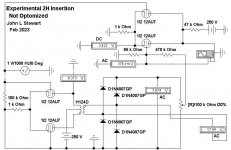 Exp 2H Insertion A.JPG48.2 KB · Views: 78
Exp 2H Insertion A.JPG48.2 KB · Views: 78 -
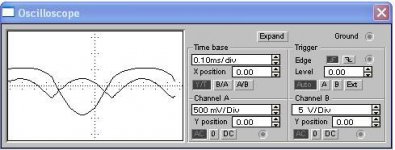 Exp 2H Insertion A2.JPG25.7 KB · Views: 67
Exp 2H Insertion A2.JPG25.7 KB · Views: 67 -
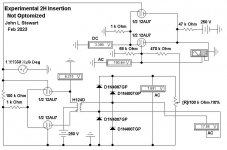 Exp 2H Insertion B.JPG48 KB · Views: 65
Exp 2H Insertion B.JPG48 KB · Views: 65 -
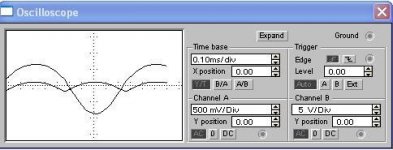 Exp 2H Insertion B2.JPG24.7 KB · Views: 64
Exp 2H Insertion B2.JPG24.7 KB · Views: 64 -
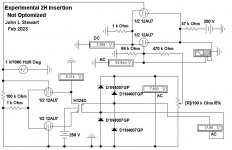 Exp 2H Insertion C.JPG50 KB · Views: 68
Exp 2H Insertion C.JPG50 KB · Views: 68 -
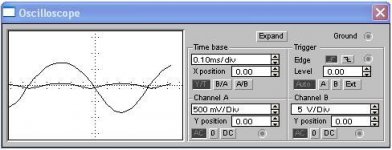 Exp 2H Insertion C2.JPG25.2 KB · Views: 73
Exp 2H Insertion C2.JPG25.2 KB · Views: 73 -
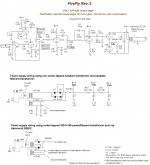 Firefly Rev 3 8W Doug Hammond.jpg146.3 KB · Views: 69
Firefly Rev 3 8W Doug Hammond.jpg146.3 KB · Views: 69 -
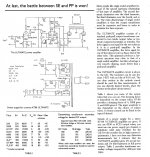 Creating Distortion Where There Was None.jpg556.5 KB · Views: 82
Creating Distortion Where There Was None.jpg556.5 KB · Views: 82
- Home
- Amplifiers
- Tubes / Valves
- choosing a Tube input topology for Class D module